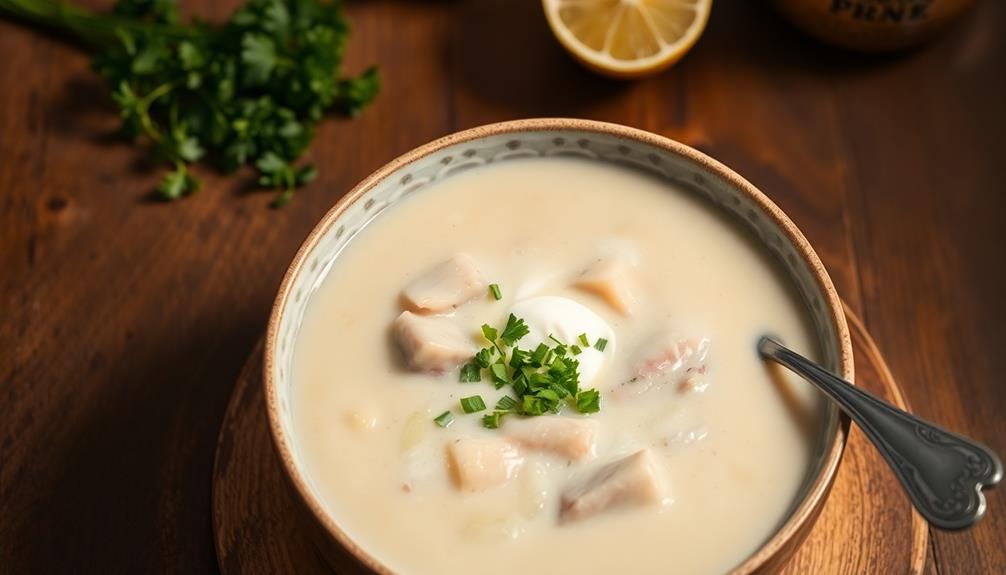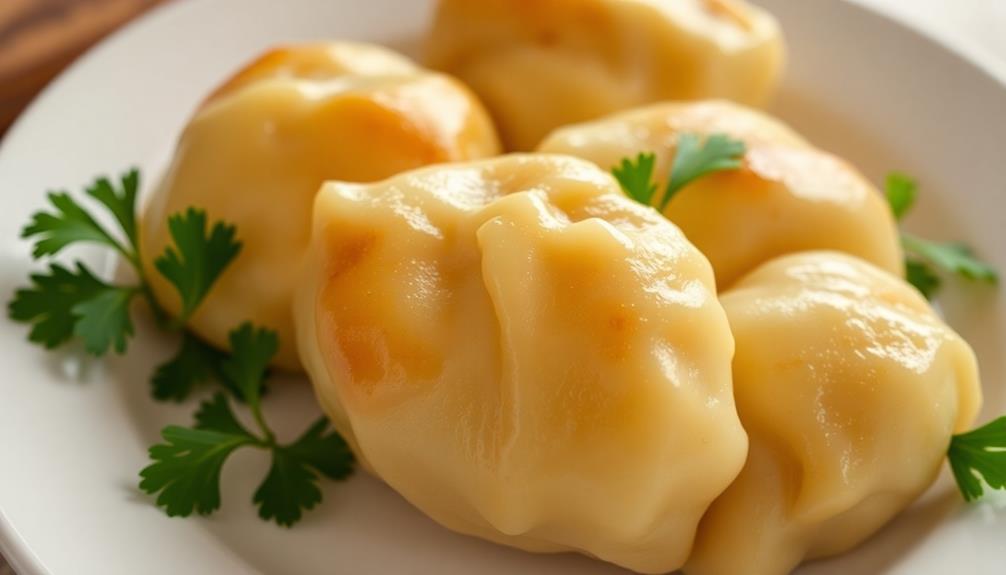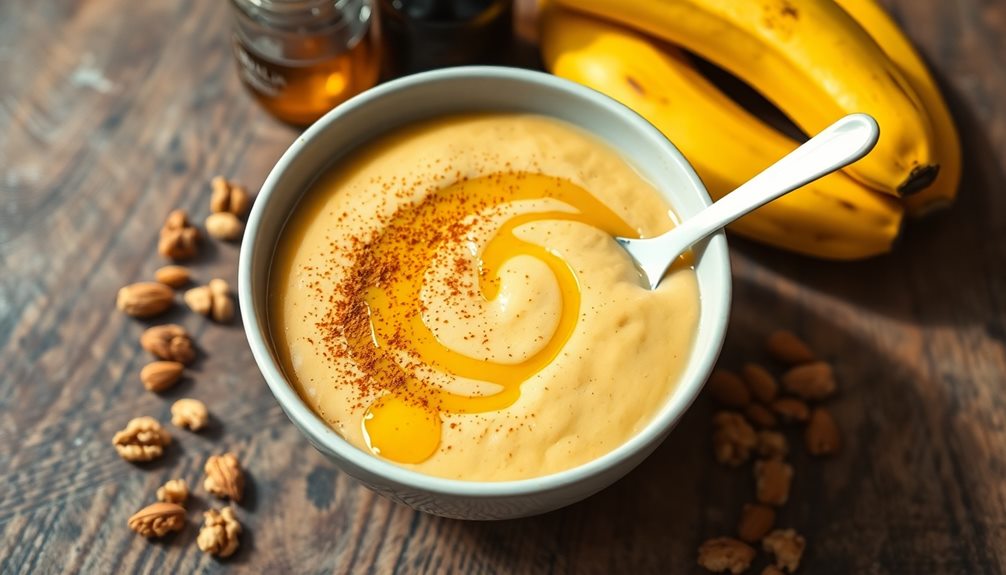Tripe soup is a comforting dish you'll find in many cultures around the world. It's made from beef stomach lining, simmered until tender in a flavorful broth with vegetables and spices. You'll love its rich taste and soft texture, perfect for warming up on chilly days. Cleaning the tripe is key to getting the best flavor, so don't skip that step! Season it with garlic, vinegar, and sour cream for a tangy kick. Serve it hot with crusty bread for a satisfying meal. This humble soup has a long history and is often thought to have healing properties. Curious about making your own? There's more to discover about this tasty tradition.
Key Takeaways
- Tripe soup is a traditional dish made from beef tripe, broth, vegetables, and seasonings, popular in various cuisines worldwide.
- Proper cleaning and preparation of tripe is essential for flavor, including rinsing, soaking, and scrubbing before cooking.
- The soup typically simmers for 2-3 hours to tenderize the tripe and develop a rich, flavorful broth.
- Common ingredients include garlic, vinegar, sour cream, and various spices, with regional variations in vegetables and seasonings.
- Tripe soup is often considered a comfort food and is believed to have healing properties, especially after celebrations.
History
Dating back centuries, tripe soup has been a staple in various cuisines around the world. You'll find this hearty dish in many cultures, from Eastern Europe to Asia and beyond. In Poland, you might know it as "flaki," while in Turkey, it's called "işkembe çorbası." Each region has put its own spin on this comforting meal, using local ingredients and spices to create unique flavors.
You'd be surprised to learn that tripe soup wasn't always considered a delicacy. In fact, it started as a way to use every part of the animal, ensuring nothing went to waste. Over time, people discovered that with the right preparation and seasoning, tripe could be transformed into a delicious and nourishing soup.
As you explore the history of tripe soup, you'll discover how it's been enjoyed by both royalty and commoners alike. In some places, it's even believed to have healing properties, especially after a night of celebration! In medieval times, tripe soup was considered a delicacy and was often served at extravagant feasts. Its reputation as a comforting and reviving dish has carried through the centuries, making it a popular choice for those in need of a pick-me-up. If you’re interested in trying a similar traditional dish, you might want to look up an authentic recipe for duck blood soup, another historical favorite in certain cultures.
Whether you're a fan of offal or just curious about traditional foods, tripe soup's rich history is sure to fascinate you.
Recipe
Tripe soup, also known as Ciorba de burta in Romanian cuisine or Iskembe çorbası in Turkish cuisine, is a hearty and flavorful dish that has been enjoyed for centuries. This comforting soup is made with tripe, the edible lining of a cow's stomach, which is cleaned, boiled, and cut into strips before being added to a rich, tangy broth.
The key to a delicious tripe soup lies in the preparation of the tripe itself and the careful balance of flavors in the broth. Typically, the soup is seasoned with garlic, vinegar, and sour cream, which give it its characteristic tangy taste. Some variations include vegetables like carrots and celery, while others keep it simple with just the tripe and broth.
- 2 lbs beef tripe, cleaned and cut into strips
- 8 cups beef or chicken broth
- 1 large onion, diced
- 2 carrots, diced
- 2 celery stalks, diced
- 4 cloves garlic, minced
- 1/4 cup white vinegar
- 1 cup sour cream
- 2 eggs, beaten
- Salt and pepper to taste
- 2 tbsp vegetable oil
- Fresh parsley for garnish
To prepare the tripe soup, first boil the tripe in salted water for about 2 hours or until tender. In a large pot, sauté the onion, carrots, and celery in vegetable oil until softened. Add the minced garlic and cook for another minute.
Pour in the broth and bring to a boil. Add the cooked tripe and simmer for 30 minutes. In a separate bowl, whisk together the sour cream, beaten eggs, and vinegar. Slowly add this mixture to the soup, stirring constantly to prevent curdling.
Season with salt and pepper to taste, and simmer for an additional 5 minutes. Serve hot, garnished with fresh parsley.
For the best results, choose high-quality tripe and clean it thoroughly before cooking. If you're short on time, you can use pre-cooked tripe, which is available in some specialty stores.
The soup can be made ahead of time and reheated, as the flavors often improve after a day or two. Some people prefer to add extra vinegar or hot sauce at the table for a more pronounced tangy or spicy flavor.
Cooking Steps
You'll want to start by thoroughly rinsing and cleaning the tripe, then simmering it until it's tender.
Next, prepare your vegetables and seasonings while the tripe cooks.
Once the tripe is ready, you'll add broth and spices to create a flavorful base, and finally thicken the soup with a bit of flour for that perfect consistency.
Step 1. Rinse and Clean Tripe Thoroughly
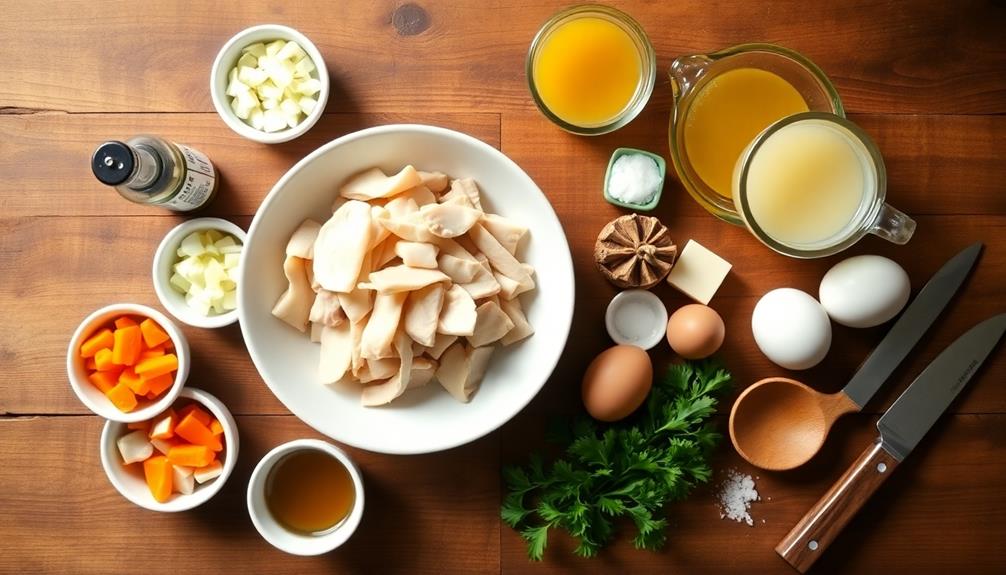
Before you begin cooking, it's crucial to thoroughly rinse and clean the tripe. Start by running cold water over the tripe, gently rubbing its surface to remove any debris. You'll want to do this for several minutes, making sure to clean both sides.
Next, fill a large bowl with cold water and add a splash of white vinegar. Submerge the tripe in this mixture for about 30 minutes. This step helps to neutralize any strong odors and further cleans the tripe.
After soaking, drain the tripe and rinse it again under cold running water. Now, it's time to give it a final scrub. Using a soft-bristled brush or a clean kitchen sponge, gently scrub the entire surface of the tripe. Pay extra attention to any crevices or folds.
You'll notice the tripe becoming lighter in color and feeling smoother to the touch. Once you're satisfied with the cleaning, pat the tripe dry with paper towels. Your tripe is now ready for cooking, and you can be confident that it's clean and free from any unwanted flavors or textures.
Step 2. Simmer Tripe Until Tender
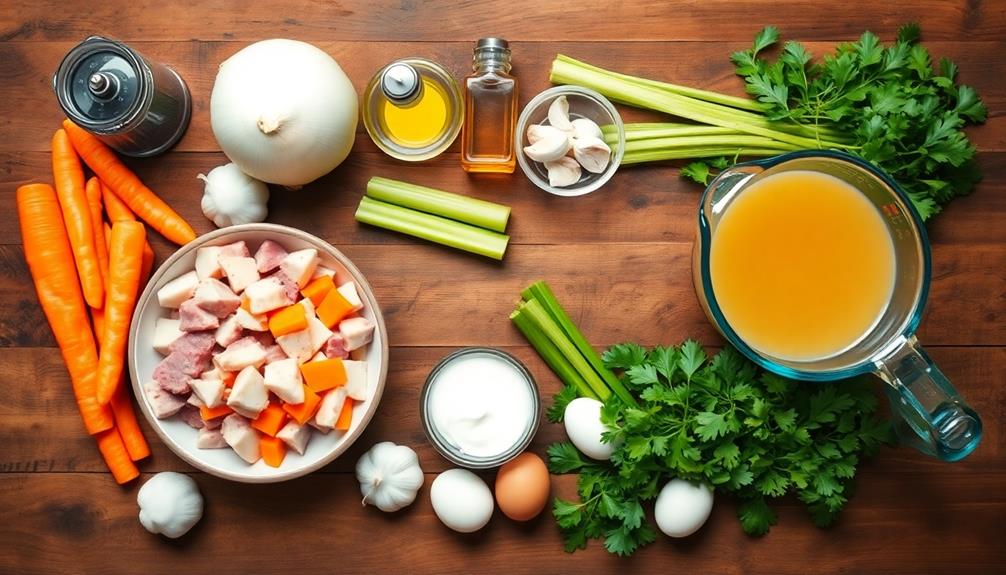
Now that you've thoroughly cleaned the tripe, it's time to simmer it until tender. Place the tripe in a large pot and cover it with cold water. Add a pinch of salt and bring the water to a boil over high heat.
Once boiling, reduce the heat to low and let the tripe simmer gently. As the tripe cooks, you'll notice it slowly becoming softer. This process takes patience, as tripe can take anywhere from 2 to 3 hours to become tender. Don't rush it!
While it simmers, you might see some foam forming on the surface. Simply skim this off with a spoon to keep your broth clear.
Every 30 minutes or so, check on your tripe. Poke it with a fork to test its tenderness. When it's ready, the tripe will feel soft and yield easily to the fork.
Step 3. Prepare Vegetables and Seasonings
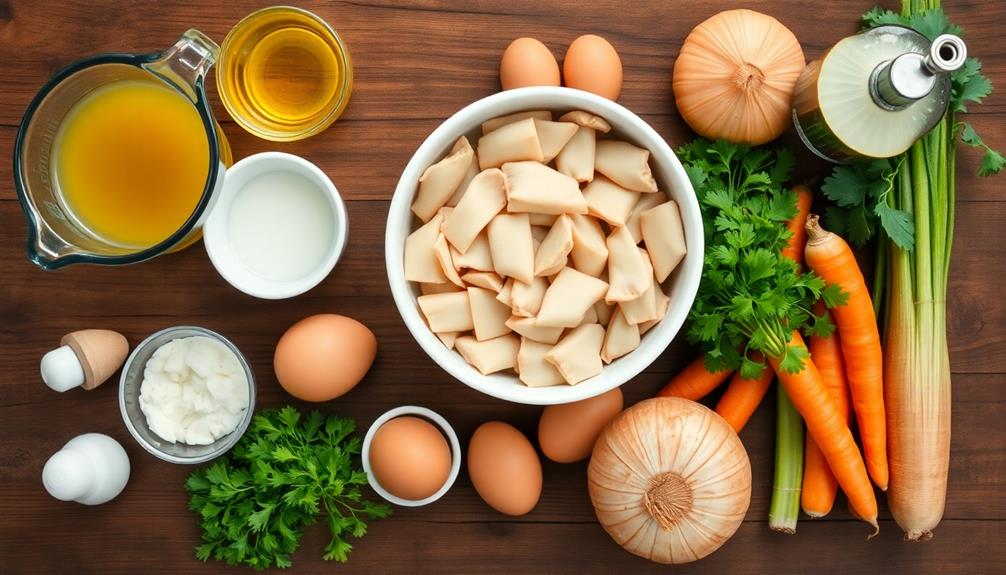
While the tripe simmers, it's time to prep the vegetables and seasonings that'll give your soup its distinctive flavor. You'll need to gather carrots, celery, onions, and garlic – the classic soup base that'll add depth to your broth. Chop these veggies into small, uniform pieces so they'll cook evenly and blend well with the tripe.
Next, let's focus on the aromatics. You'll want to grab some bay leaves, whole peppercorns, and a pinch of marjoram. These herbs and spices will infuse your soup with a warm, comforting aroma that'll make your kitchen smell amazing.
Don't forget to add a dollop of tomato paste for richness and color.
Now, it's time to get creative! Some cooks like to add a splash of white wine for acidity, while others swear by a dash of paprika for a subtle smoky flavor. You can even toss in some diced potatoes if you're looking for a heartier soup.
Step 4. Add Broth and Spices
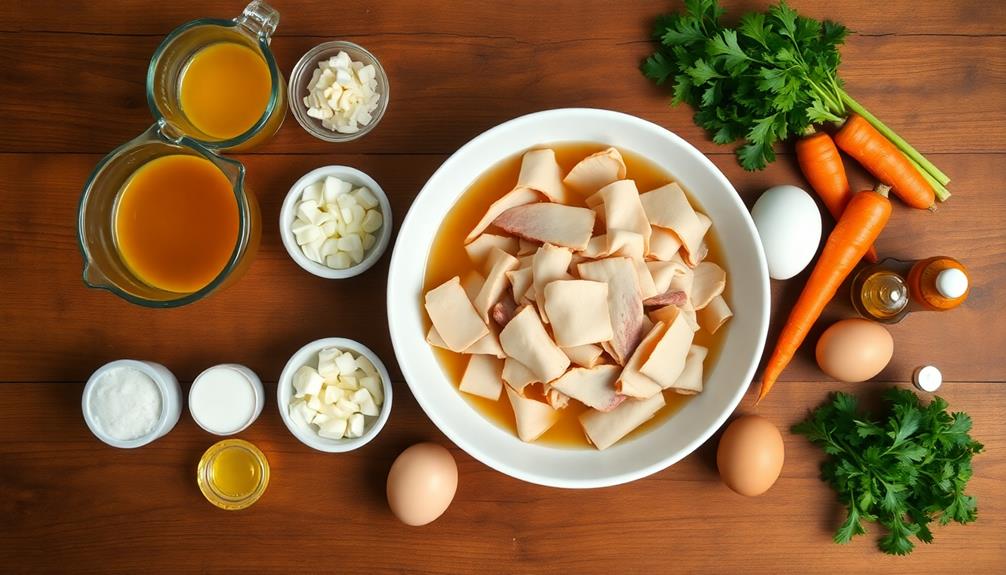
With the vegetables and seasonings prepped, it's time to add the broth and spices to your tripe soup. Pour in the rich beef broth, watching as it covers the tripe and vegetables. The golden liquid will bring everything together, creating a flavorful base for your soup.
Now, let's spice things up!
Grab your spice rack and get ready to add some magic. Sprinkle in a generous pinch of marjoram, which will give your soup a delightful herbal aroma. Next, add some bay leaves – they'll infuse the broth with a subtle, earthy flavor. Don't forget the paprika! Its vibrant red color and slightly sweet taste will make your soup even more enticing.
As the spices mingle with the broth, you'll notice the kitchen filling with an irresistible aroma. Give the soup a gentle stir, making sure all the ingredients are well combined. The spices will dance together, creating a symphony of flavors that'll make your taste buds sing.
You're well on your way to a delicious tripe soup that'll warm your soul and impress your guests!
Step 5. Thicken Soup With Flour
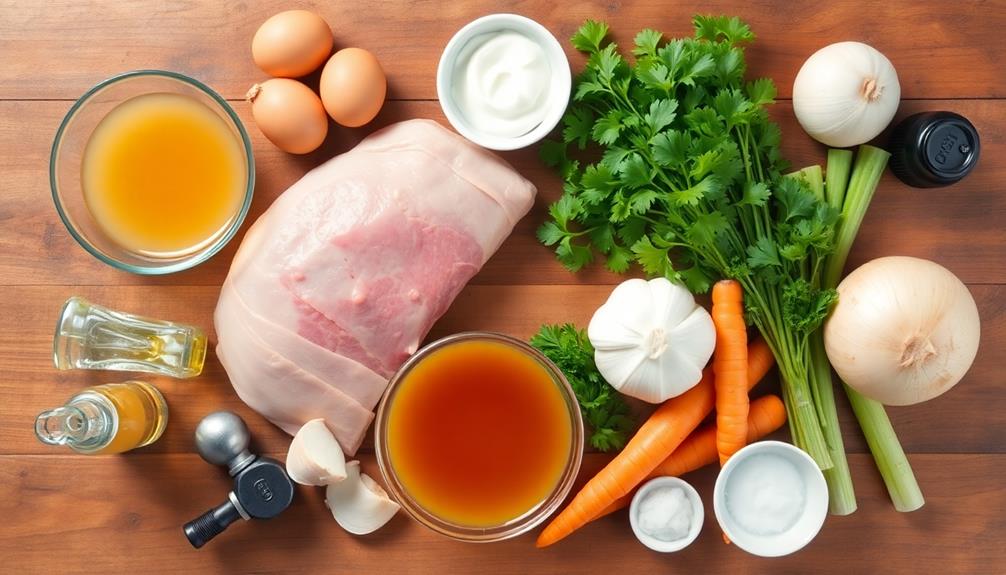
As the flavors meld in your pot, it's time to give your tripe soup a hearty, velvety texture. You'll want to thicken it up with a simple flour mixture.
In a small bowl, combine about 2 tablespoons of all-purpose flour with a splash of cold water. Whisk them together until you've got a smooth paste without any lumps.
Now, here's the fun part! Slowly pour this mixture into your simmering soup, stirring constantly. You'll see the magic happen as the broth starts to thicken before your eyes.
Keep stirring for a few minutes to make sure the flour is well incorporated and cooked through. This step is crucial to avoid any raw flour taste in your delicious tripe soup.
If you find your soup is still too thin, don't worry! You can repeat this process with small amounts of flour paste until you reach your desired consistency.
Final Thoughts
Tripe soup stands as a testament to culinary resourcefulness and cultural diversity. As you've learned, this hearty dish transforms humble ingredients into a comforting meal that's cherished in many parts of the world.
Whether you're adventurous enough to try making it at home or plan to sample it at a local restaurant, you're in for a unique culinary experience.
Remember, the key to a great tripe soup lies in proper cleaning and preparation of the tripe, as well as patient simmering to achieve that rich, flavorful broth.
Don't be afraid to experiment with different spices and vegetables to make it your own. The beauty of tripe soup is its adaptability to various tastes and traditions.
As you savor each spoonful, think about the generations of cooks who've perfected this recipe and the cultural significance it holds.
It's more than just a meal; it's a journey through history and across borders.
Frequently Asked Questions
Is Flaki a Healthy Dish?
You might be wondering about the health benefits of flaki. While it's packed with protein and nutrients, it's not the healthiest dish out there.
It's often high in fat and cholesterol, which can be a concern if you're watching your heart health. However, it does contain vitamins and minerals that are good for you.
If you enjoy it, it's okay to have occasionally, but it's best not to make it a regular part of your diet.
Can Flaki Be Made With Vegetarian Alternatives?
Yes, you can definitely make vegetarian versions of this hearty soup!
You'll want to swap out the tripe for plant-based alternatives like mushrooms, seitan, or textured vegetable protein. These options provide a similar chewy texture.
Don't forget to use vegetable broth instead of beef stock. You can keep all the aromatic vegetables and spices to maintain that rich, comforting flavor.
With a few clever substitutions, you'll create a delicious meat-free version that's just as satisfying as the original!
How Long Does Flaki Typically Last in the Refrigerator?
You'll want to enjoy your delicious flaki within 3-4 days for the best flavor and safety.
After cooking, let it cool completely before storing it in an airtight container in your fridge. Remember, the sooner you eat it, the tastier it'll be!
If you've made a big batch, you can freeze portions for up to 3 months. Just be sure to thaw and reheat thoroughly before savoring your comforting soup again.
Are There Regional Variations of Flaki in Different Polish Cities?
You'll find regional variations of flaki across Poland! Each city adds its own twist to this beloved dish.
In Warsaw, you might taste a spicier version, while Krakow's flaki often includes more vegetables. Some cities use different cuts of tripe or add unique spices.
In coastal areas, you could even find seafood-inspired versions. Don't be surprised if you encounter flaki with dumplings or served with different side dishes as you travel through Poland's diverse regions!
What Are the Best Side Dishes to Serve With Flaki?
You'll love pairing your flaki with some tasty side dishes!
Try serving it with fresh, crusty bread to soak up the savory broth. A crisp green salad adds a refreshing touch.
Roasted or mashed potatoes are perfect for a heartier meal. Don't forget pickles or sauerkraut for a tangy kick!
If you're feeling adventurous, add some spicy horseradish on the side.
These options will make your flaki experience even more delicious and satisfying.
